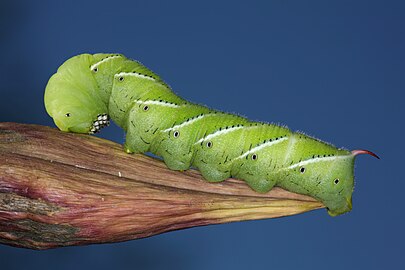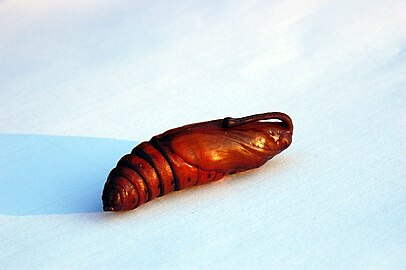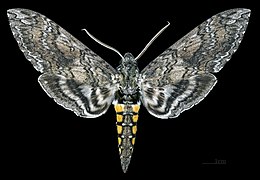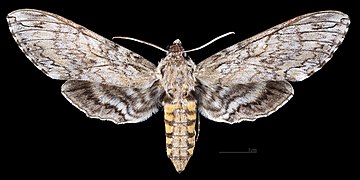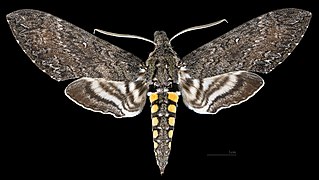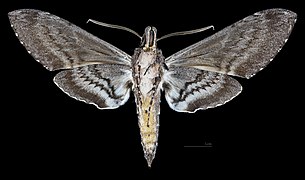Manduca sexta
| Manduca sexta | |
|---|---|
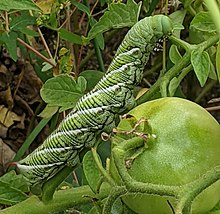
| |
| Caterpillar | |

| |
| Adult moth | |
| Scientific classification | |
| Domain: | Eukaryota |
| Kingdom: | Animalia |
| Phylum: | Arthropoda |
| Class: | Insecta |
| Order: | Lepidoptera |
| Family: | Sphingidae |
| Genus: | Manduca |
| Species: | M. sexta
|
| Binomial name | |
| Manduca sexta | |
| Synonyms | |
| |
Manduca sexta is a moth of the family Sphingidae present through much of the Americas. The species was first described by Carl Linnaeus in his 1763 Centuria Insectorum.
Commonly known as the Carolina sphinx moth and the tobacco hawk moth (as adults) and the tobacco hornworm and the Goliath worm (as larvae), it is closely related to and often confused with the very similar tomato hornworm (Manduca quinquemaculata); the larvae of both feed on the foliage of various plants of the family Solanaceae. The larvae of these species can be distinguished by their lateral markings: Tomato hornworms have eight V-shaped white markings with no borders; tobacco hornworms have seven white diagonal lines with a black border. Additionally, tobacco hornworms have red horns, while tomato hornworms have dark blue or black horns.[2] A mnemonic to remember the markings is tobacco hornworms have straight white lines like cigarettes, while tomato hornworms have V-shaped markings (as in "vine-ripened" tomatoes). M. sexta has mechanisms for selectively sequestering and secreting the neurotoxin nicotine present in tobacco. [citation needed]
M. sexta is a common model organism, especially in neurobiology, due to its easily accessible nervous system and short life cycle. Due to its immense size M. sexta is big enough for medical imaging modalities (like CT, MRI, or PET) and used as a model in imaging and gut inflammation.[3] It is used in a variety of biomedical and biological scientific experiments. It can be easily raised on a wheat-germ-based diet. The larva is large, and thus it is relatively easy to dissect it and isolate its organs.
Life cycle
[edit]M. sexta has a short life cycle, lasting about 30 to 50 days. In most areas, M. sexta has about two generations per year, but can have three or four generations per year in Florida.[4]
Eggs
[edit]M. sexta eggs are spherical, approximately 1.5 millimeters in diameter, and translucent green.[2] They typically hatch two to four days after they are laid. Eggs are normally found on the underside of foliage, but can also be found on the upper surface.
Larva
[edit]M. sexta larvae are bright green in color and grow up to 100 millimeters in length. The posterior abdominal segment is tipped with a dorsocaudal horn that earns them the name "hornworm". The final instar consists of a cylindrical body covered with fine hairlike setae. The head is equipped with a pair of ocelli and chewing mouthparts. Each of the three thoracic segments bears a pair of true legs, and there is a pair of prolegs on the third, fourth, fifth, sixth, and last abdominal segments in all larval instars. The prothoracic segment bears one pair of spiracles, and additional pairs occur on each of the eight abdominal segments.[5]
The hemolymph (blood) of this species contains insecticyanin, a blue-colored biliprotein. When the larva feeds on its normal diet of plant foliage, it ingests pigmentacious carotenoids, which are primarily yellow in hue. The resulting combination is green. Under laboratory conditions—when fed a wheat-germ-based diet—larvae are turquoise in color due to the lack of carotenoids in their diet.[citation needed]
The caterpillar stage of the tobacco hornworm is quite similar in appearance to that of the closely related tomato hornworm. The larvae of these two species can however be readily distinguished by their lateral markings. Specifically, the M. sexta caterpillar has seven white diagonal lines with a black border at the first seven abdominal segments, and the horn is red or green with a red tip. The M. quinquemaculatacaterpillar has V-shaped white markings with no borders at all eight of its abdominal segments, and the horn is dark blue or black in color.[6]
During the larval stage, M. sexta caterpillars feed on plants of the family Solanaceae, principally tobacco, tomatoes and members of the genus Datura. M. sexta has five larval instars, which are separated by ecdysis (molting), but may add larval instars when nutrient conditions are poor. Near the end of this stage, the caterpillar seeks a location for pupation, burrows underground, and pupates. This searching behavior is known as "wandering". The imminence of pupation—suggested behaviorally by the wandering—can be anatomically confirmed by spotting the heart (aorta), which is a long, pulsating vessel running along the length of the caterpillar's dorsal side. The heart becomes visible through the skin just as the caterpillar is reaching the end of the final instar.
A common biological control for hornworms is the parasitic braconid wasp Cotesia congregata, which lays its eggs in the bodies of the hornworms. The wasp larvae feed internally and emerge from the body to spin their cocoons. Parasitized hornworms are often seen covered with multiple white, cottony wasp cocoons, which are often mistaken for large eggs. A wasp species, Polistes erythrocephalus, feeds on hornworm larvae.[7]

-
In the larval state its back end might be confused as its head.
-
With parasitic wasp cocoons
-
Pupa
Pre-pupa
[edit]Before the larva pupates, it goes through a stage called the pre-pupa, where it shrinks considerably and prepares to pupate. Often people mistake this stage for a dead or dying caterpillar.
Pupa
[edit]The pupal stage lasts approximately 14–18 days under laboratory conditions (17 hours light, 7 hours dark, 27 °C). When reared on a short-day photoperiod (12 hours light, 12 hours dark), pupae enter a state of diapause that can last several months. During the pupal stage, structures of the adult moth form within the pupal case, which is shed during eclosion (adult emergence).
Adult
[edit]Adult M. sexta have narrow wings with a wing span of approximately 100 mm. M. sexta moths are nectarivorous and feed on flowers, demonstrating a remarkable ability to hover.
Adults are sexually dimorphic. Males are identifiable by their broader antennae and the presence of claspers at the end of the abdomen. Female moths are typically ready to mate one week after eclosion, and do so only once. Males may mate many times. Mating generally occurs on a vertical surface at night, and can last several hours, with the male and female facing in opposite positions, their posterior ends touching. After mating, females deposit their fertilized eggs on foliage, usually on the underside of leaves.
-
Male
-
Male underside
-
Female
-
Female underside
Laboratory rearing
[edit]Like Drosophila melanogaster, M. sexta is commonly used as a model organism for experiments. They are frequently studied in the laboratory due to their large size and relative ease of rearing. They may be reared on host plants, such as tobacco and tobacco relatives, tomato plants, or wheat-germ-based artificial diet. Their rearing is straightforward, provided they receive a long daylight cycle (e.g., 14 hours) during development to prevent diapause.
Eggs are rinsed for one to five minutes in dilute household bleach for disinfection.
Eggs are placed on diet cubes or host plants. The eggs hatch and develop at different speeds depending on temperature. The larvae are moved to a fresh diet or leaves as their food spoils or is consumed. When they start to "wander", they are about to pupate, so are placed in a pupation chamber. Pupation chambers are holes drilled into a wood board. The Manduca larvae are sealed in the chamber using a stopper and allowed to pupate. After pupation, the pupae are placed in a breeding or colony chamber to eclose. Providing a cup of sugar water and a tobacco (or related) plant will allow mated females to oviposit fertile eggs, which can then be reared.
When fed an artificial diet, Manduca larvae do not consume the xanthophyll -which is a yellow pigment- needed to produce their green coloration; instead they appear blue. On some diets, they have very little pigment and pigment precursors, so are a very pale blue-white. As vitamin A and other carotenoids are necessary for the visual pigments (rhodopsin), an artificial-diet-reared hornworm may have poor vision due to lack of carotenoids in the diet.[8]
As pet food
[edit]Captive-bred hornworms fed on an artificial diet are often given to insectivorous exotic animals, such as certain reptiles, fish and small mammals. They are preferred over wild-collected hornworms, which may bioaccumulate poisonous substances found in dietary plants. Hornworms, though originally bred for laboratories, are also farmed for this purpose.[9][10][11] They are often sold already packed into pods that include everything the larvae need, including food. Care is relatively easy, and animals seem to relish their bright color and flavor.[12]
Animal model
[edit]M. sexta larvae grow up to 100 millimeters in length, reaching up to 20 grams. Due to their large size, they are used as alternative animal models for medical imaging modalities like computed tomography, magnetic resonance imaging, or positron emission tomography.[13] Researchers around Anton Windfelder have established the larvae of M. sexta as an alternative animal model for chronic inflammatory bowel diseases or as an animal model for testing new contrast agents for radiology.[14]
Subspecies
[edit]- Manduca sexta sexta (North and Central America)
- M. s. caestri (Blanchard, 1854) (Chile)
- M. s. jamaicensis (Butler, 1875) (Caribbean)
- M. s. leucoptera (Rothschild & Jordan, 1903) (Galápagos Islands)
- M. s. paphus (Cramer, 1779) (South America)
- M. s. saliensis (Kernbach, 1964) (Argentina)
- M. s. garapa (Pixley, 2016) (Saipan)
-
Manduca sexta jamaicensis
Male dorsal -
Manduca sexta jamaicensis
Male ventral -
Manduca sexta jamaicensis
Female dorsal -
Manduca sexta jamaicensis
Female ventral
-
Manduca sexta leucoptera
Female dorsal -
Manduca sexta leucoptera
Female ventral
-
Manduca sexta paphus
Male dorsal -
Manduca sexta paphus
Male ventral
Behavior
[edit]Feeding
[edit]Tobacco hornworms are facultative specialists; the larvae can grow and develop on any host plants. However, the larvae prefer solanaceous plants, such as tobacco and tomato plants. On these types of plants, larvae grow and develop faster. The lateral and medial sensilla styloconia (sensory receptors) on their mouthparts help them to identify solanaceous plants by recognizing indioside D, a steroidal glycoside found in those particular plants (del Campo et al., 2001).[15][16] Salicin is a distasteful phagodeterrent, found only in Salix spp. while caffeine is a phagodeterrent that is actually toxic.[16] Schoonhoven 1969 found that M. sexta habituation to salicin is mediated by desensitization of the deterrence associated peripheral neurons and Glendinning et al. 1999 the same for caffeine.[16] However Glendinning et al. 2001 find only a small peripheral desensitization for salicin, concluding that Schoonhoven erred, and that habituation in this case is centrally mediated.[16] Tobacco hornworms are considered pests because they feed on the upper leaves of tobacco plants and leave green or black droppings on the plants. As adults, they do not damage plants since they feed on nectar.[17]
Tobacco hornworm larvae prefer humid environments. When dehydrated, tobacco hornworm larvae will move towards a source of water or to an area with a high relative level of humidity. They use their antennae to locate water to drink .[18]
Defense
[edit]Nicotine is poisonous to most animals that use muscles to move because nicotine targets the acetylcholine receptor at the neuromuscular junction. However, the tobacco hornworm is capable of metabolizing nicotine from the tobacco plant and using nicotine as a defense against predators. It possesses a gene called cytochrome P450 6B46 (CYP6B46) that converts nicotine into a metabolite. About 0.65% of nicotine metabolites are transported from the gut to the hemolymph, where they are reconverted to nicotine and released into the air from the tobacco hornworm's spiracles. The emitted nicotine is used as a way to deter spiders, a practice known as “toxic halitosis.” In one study, tobacco hornworms that fed from nicotine-deficient plants or expressed low levels of CYP6B46 were more susceptible to wolf spider predation.[19]
Tobacco hornworm caterpillars emit short clicking sounds from their mandibles when they are being attacked. This sound production is believed to be a type of acoustic aposematism, or warning sounds that let predators know that trying to eat them will be troublesome; tobacco hornworms have been observed to thrash and bite predators after producing those clicking sounds. These clicks can be heard at a close distance with a frequency range of 5 to 50 kHz. The intensity of clicks increases with the number of attacks (Bura et al., 2012).[20]
Gallery
[edit]-
Illustration from John Curtis's British Entomology Volume 5, possibly the only British record for this species
-
Feeding on tomato plant
-
Manduca sexta parasitized by Cotesia congregata wasp larvae
-
A tobacco hornworm with wasp cocoons
References
[edit]- ^ "CATE Creating a Taxonomic eScience – Sphingidae". Cate-sphingidae.org. Archived from the original on November 14, 2012. Retrieved June 16, 2011.
- ^ a b Villanueva, Raul (June 2009). "Featured Creatures". University of Florida/IFAS. Retrieved October 12, 2012.
- ^
- Asai, Masanori; Li, Yanwen; Newton, Sandra; Robertson, Brian; Langford, Paul (2023). "Galleria mellonella–intracellular bacteria pathogen infection models: the ins and outs". FEMS Microbiology Reviews. 47 (2). Oxford University Press (OUP). doi:10.1093/femsre/fuad011. hdl:10044/1/103485. ISSN 1574-6976. PMC 10045907. PMID 36906279. S2CID 257483883. Federation of European Microbiological Societies (FEMS).
- This review cites this research.
- Windfelder, Anton G.; Müller, Frank H. H.; Mc Larney, Benedict; Hentschel, Michael; Böhringer, Anna Christina; von Bredow, Christoph-Rüdiger; Leinberger, Florian H.; Kampschulte, Marian; Maier, Lorenz; von Bredow, Yvette M.; Flocke, Vera; Merzendorfer, Hans; Krombach, Gabriele A.; Vilcinskas, Andreas; Grimm, Jan (November 24, 2022). "High-throughput screening of caterpillars as a platform to study host–microbe interactions and enteric immunity". Nature Communications. 13 (1): 7216. Bibcode:2022NatCo..13.7216W. doi:10.1038/s41467-022-34865-7. ISSN 2041-1723. PMC 9700799. PMID 36433960.
- ^ Eichman, Aaron; Weston Tripp; Matt Edwards (2000). "Manduca sexta "Carolina sphinx"". Archived from the original on September 8, 2006. Retrieved October 21, 2006.
- ^ Casanova, Rafael Inglés; Gaud, Silverio Medina (1975). "Notes on the Life Cycle of the Tobacco Hornworm, Manduca sexta (L.) (Lepidoptera; Sphingidae), in Puerto Rico". Journal of Agriculture of the University of Puerto Rico. 59 (1): 51–62. doi:10.46429/JAUPR.V59I1.10629. ISSN 0041-994X. S2CID 82843148.
- ^ Villanueva, Raul (1998). "Tobacco Hornworm".
- ^ "Biologia y comportamiento de Polistes erythrocephalus" (PDF). Biology. bdigital.unal.edu. Retrieved October 14, 2014.
- ^ Goyret, Joaquin; Kelber, Almut; Pfaff, Michael; Raguso, Robert (2009). "Flexible responses to visual and olfactory stimuli by foraging Manduca sexta: larval nutrition affects adult behaviour". Proceedings of the Royal Society B: Biological Sciences. 276 (1668): 2739–2745. doi:10.1098/rspb.2009.0456. PMC 2839956. PMID 19419987.
- ^ "Great Lakes Hornworms". Great Lakes Hornworm.
- ^ "Live Hornworms". Mulberry Farms. Retrieved November 21, 2022.
- ^ "Hornworms AKA Goliath Worms". Rainbow Mealworms.
- ^ "Goliath Horn Worm – Goliath Horn Worm – Insect Feeders – Resources". thereptilecenter.com. Archived from the original on August 28, 2016. Retrieved November 21, 2015.
- ^ Windfelder, Anton G.; Müller, Frank H. H.; Mc Larney, Benedict; Hentschel, Michael; Böhringer, Anna Christina; von Bredow, Christoph-Rüdiger; Leinberger, Florian H.; Kampschulte, Marian; Maier, Lorenz; von Bredow, Yvette M.; Flocke, Vera; Merzendorfer, Hans; Krombach, Gabriele A.; Vilcinskas, Andreas; Grimm, Jan (November 24, 2022). "High-throughput screening of caterpillars as a platform to study host–microbe interactions and enteric immunity". Nature Communications. 13 (1): 7216. Bibcode:2022NatCo..13.7216W. doi:10.1038/s41467-022-34865-7. ISSN 2041-1723. PMC 9700799. PMID 36433960.
- ^ Koshkina, Olga; Rheinberger, Timo; Flocke, Vera; Windfelder, Anton; Bouvain, Pascal; Hamelmann, Naomi M.; Paulusse, Jos M. J.; Gojzewski, Hubert; Flögel, Ulrich; Wurm, Frederik R. (July 19, 2023). "Biodegradable polyphosphoester micelles act as both background-free 31P magnetic resonance imaging agents and drug nanocarriers". Nature Communications. 14 (1): 4351. Bibcode:2023NatCo..14.4351K. doi:10.1038/s41467-023-40089-0. ISSN 2041-1723. PMC 10356825. PMID 37468502.
- ^ del Campo, M.L.; Miles, C.I.; Schroeder, F.C.; Mueller, C.; Booker, R.; Renwick, J.A. (2001). "Host recognition by the tobacco hornworm is mediated by a host plant compound". Nature. 411 (6834): 186–189. Bibcode:2001Natur.411..186D. doi:10.1038/35075559. PMID 11346793. S2CID 4342772.
- ^ a b c d Chapman, R. F. (2003). "Contact Chemoreception in Feeding by Phytophagous Insects". Annual Review of Entomology. 48 (1). Annual Reviews: 455–484. doi:10.1146/annurev.ento.48.091801.112629. ISSN 0066-4170. PMID 12414737. S2CID 20607683.
- ^ Puvuk, Dan (September 23, 2009). "The Tomato Hornworm and the Tobacco Hornworm". Michigan State University. Retrieved April 20, 2014.
- ^ Rowley, M.; Hanson, F. (2007). "Humidity detection and hygropreference behavior in larvae of the tobacco hornworm, Manduca sexta". Journal of Insect Science. 7 (39): 1–10. doi:10.1673/031.007.3901. PMC 2999434. PMID 20302460.
- ^ Kumar, P.; Pandit, S.S.; Steppuhn, A.; Baldwin, I.T. (2013). "Natural history-driven, plant-mediated RNAi-based study reveals CYP6B46's role in a nicotine-mediated antipredator herbivore defense". Proceedings of the National Academy of Sciences of the United States of America. 111 (4): 1245–52. doi:10.1073/pnas.1314848111. PMC 3910579. PMID 24379363.
- ^ Bura, V.L.; Hnain, A.K.; Hick, J.N.; Yack, J.E. (2012). "Defensive sound production in the tobacco hornworm, Manduca sexta (Bombycoidea: Sphingidae)". Journal of Insect Behavior. 25 (2): 114–126. doi:10.1007/s10905-011-9282-8. S2CID 18667417.
Further reading
[edit]- Van Griethuijsen, L. I.; Banks, K. M.; Trimmer, B. A. (2013). "Spatial accuracy of a rapid defense behavior in caterpillars". Journal of Experimental Biology. 216 (3): 379–387. doi:10.1242/jeb.070896. PMID 23325858.
- Bura, Veronica L.; Hnain, Antoine K.; Hick, Justin N.; Yack, Jayne E. (2011). "Defensive Sound Production in the Tobacco Hornworm, Manduca sexta (Bombycoidea: Sphingidae)". Journal of Insect Behavior. 25 (2): 114–126. doi:10.1007/s10905-011-9282-8. S2CID 18667417.
- Windfelder, Anton G., Jessica Steinbart, Leonie Graser, Jan Scherberich, Gabriele A. Krombach, and Andreas Vilcinskas. "An Enteric Ultrastructural Surface Atlas of the Model Insect Manduca sexta." iScience (2024).doi.org/10.1016/j.isci.2024.109410
- Windfelder, Anton G., Jessica Steinbart, Ulrich Flögel, Jan Scherberich, Marian Kampschulte, Gabriele A. Krombach, and Andreas Vilcinskas. "A quantitative micro-tomographic gut atlas of the lepidopteran model insect Manduca sexta." Iscience 26, no. 6 (2023). doi.org/10.1016/j.isci.2023.106801
External links
[edit]- Fact sheet. Colorado State University.
- Manduca sexta. Butterflies and Moths of North America.
- Microscopy.
- Modelling insect wings using the finite element method
- Manduca sexta: A Model Organism for Imaging and Immunology

